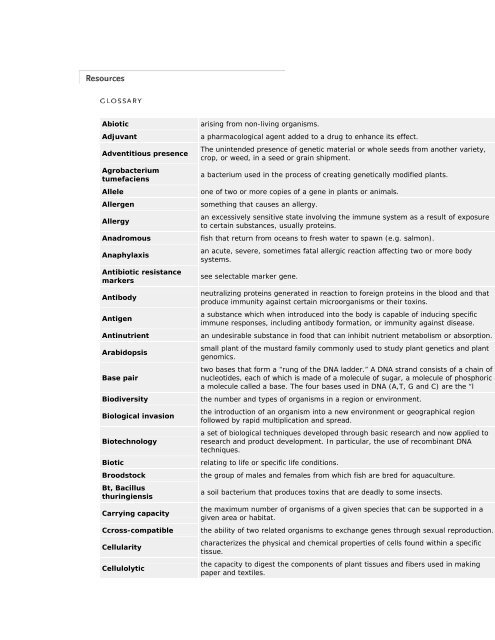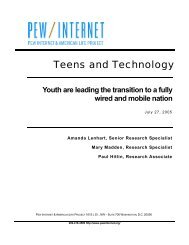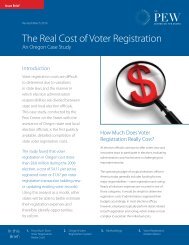Abiotic arising from non-living organisms. Adjuvant a - The Pew ...
Abiotic arising from non-living organisms. Adjuvant a - The Pew ...
Abiotic arising from non-living organisms. Adjuvant a - The Pew ...
You also want an ePaper? Increase the reach of your titles
YUMPU automatically turns print PDFs into web optimized ePapers that Google loves.
<strong>Abiotic</strong><br />
<strong>Adjuvant</strong><br />
Adventitious presence<br />
Agrobacterium<br />
tumefaciens<br />
Allele<br />
Allergen<br />
Allergy<br />
Anadromous<br />
Anaphylaxis<br />
Antibiotic resistance<br />
markers<br />
Antibody<br />
Antigen<br />
Antinutrient<br />
Arabidopsis<br />
Base pair<br />
Biodiversity<br />
Biological invasion<br />
Biotechnology<br />
Biotic<br />
Broodstock<br />
Bt, Bacillus<br />
thuringiensis<br />
Carrying capacity<br />
Ccross-compatible<br />
Cellularity<br />
Cellulolytic<br />
<strong>arising</strong> <strong>from</strong> <strong>non</strong>-<strong>living</strong> <strong>organisms</strong>.<br />
a pharmacological agent added to a drug to enhance its effect.<br />
<strong>The</strong> unintended presence of genetic material or whole seeds <strong>from</strong> another variety,<br />
crop, or weed, in a seed or grain shipment.<br />
a bacterium used in the process of creating genetically modified plants.<br />
one of two or more copies of a gene in plants or animals.<br />
something that causes an allergy.<br />
an excessively sensitive state involving the immune system as a result of exposure<br />
to certain substances, usually proteins.<br />
fish that return <strong>from</strong> oceans to fresh water to spawn (e.g. salmon).<br />
an acute, severe, sometimes fatal allergic reaction affecting two or more body<br />
systems.<br />
see selectable marker gene.<br />
neutralizing proteins generated in reaction to foreign proteins in the blood and that<br />
produce immunity against certain micro<strong>organisms</strong> or their toxins.<br />
a substance which when introduced into the body is capable of inducing specific<br />
immune responses, including antibody formation, or immunity against disease.<br />
an undesirable substance in food that can inhibit nutrient metabolism or absorption.<br />
small plant of the mustard family commonly used to study plant genetics and plant<br />
genomics.<br />
two bases that form a “rung of the DNA ladder.” A DNA strand consists of a chain of<br />
nucleotides, each of which is made of a molecule of sugar, a molecule of phosphoric a<br />
a molecule called a base. <strong>The</strong> four bases used in DNA (A,T, G and C) are the “l<br />
the number and types of <strong>organisms</strong> in a region or environment.<br />
the introduction of an organism into a new environment or geographical region<br />
followed by rapid multiplication and spread.<br />
a set of biological techniques developed through basic research and now applied to<br />
research and product development. In particular, the use of recombinant DNA<br />
techniques.<br />
relating to life or specific life conditions.<br />
the group of males and females <strong>from</strong> which fish are bred for aquaculture.<br />
a soil bacterium that produces toxins that are deadly to some insects.<br />
the maximum number of <strong>organisms</strong> of a given species that can be supported in a<br />
given area or habitat.<br />
the ability of two related <strong>organisms</strong> to exchange genes through sexual reproduction.<br />
characterizes the physical and chemical properties of cells found within a specific<br />
tissue.<br />
the capacity to digest the components of plant tissues and fibers used in making<br />
paper and textiles.
Chimera<br />
Chromatography<br />
Chromosome<br />
Clone<br />
Confined field trial<br />
Congeneric<br />
Conspecific<br />
Cry<br />
Delta-endotoxins<br />
Developmental<br />
asynchrony<br />
DNA (deoxyribonucleic<br />
acid)<br />
DNA sequence<br />
Dormancy<br />
Eclosion<br />
Ecological amplitude<br />
Eexpression (as in gene<br />
expression)<br />
Epiphytic<br />
Epistatic<br />
Epitopes<br />
Erucic acid<br />
Escherichia coli (E. coli)<br />
Exotic<br />
Fibroblasts<br />
Field trial<br />
Fitness<br />
Flow cytometry<br />
Gamete<br />
Gene<br />
Gene construct<br />
Gene flow<br />
Gene gun<br />
an organism containing two or more genetically distinct cell or tissue types.<br />
a technique for separating complex mixtures of chemicals or proteins into their<br />
various constituents.<br />
a threadlike strand of DNA and associated proteins that is in the nucleus of a cell.<br />
one that is an exact replica of another, i.e. <strong>organisms</strong> asexually derived by division<br />
<strong>from</strong> a single cell.<br />
field trial carried out with specific restrictions on location, plot size, etc.<br />
belonging to the same generation.<br />
belonging to the same species.<br />
designation of a gene encoding insecticidal crystal proteins in the soil bacterium<br />
Bacillus thuringiensis.<br />
Bt insecticidal proteins.<br />
a pattern of development within sub-populations that allows different<br />
sub-populations to reach sexual maturity at different times.<br />
the molecule that encodes genetic information.<br />
the specific order of bases in a DNA molecule, whether in a fragment of DNA, a<br />
gene, a chromosome or an entire genome.<br />
a delay in the growth of viable seeds because of unfavorable environmental<br />
conditions.<br />
the emergence of an insect larva <strong>from</strong> the egg.<br />
the range of environmental conditions in which an organism can survive and<br />
reproduce.<br />
generation of a messenger RNA (mRNA) copy of a gene encoded in an organism’s<br />
DNA.<br />
one organism <strong>living</strong> within or upon another without causing harm.<br />
a dependent relationship between genes.<br />
separate antigenic areas within a given protein.<br />
a fatty acid having 22 carbons and one double bond that is common to traditional<br />
rapeseed oil. Canola oil contains less than 2 percent erucic acid.<br />
a bacterium found in the intestine of animals and humans used extensively in<br />
genetic engineering. E. coli can be fatal to humans if undercooked meat is digested.<br />
<strong>non</strong>-native; refers to an organism that has been introduced into an area.<br />
irregularly shaped, branching cells distributed throughout vertebrate connective<br />
tissue.<br />
tests of the ability of a new crop variety to perform under normal cultivation<br />
conditions.<br />
the genetic contribution of an individual to the next generation.<br />
a technique for rapid automatic separation of suspensions of <strong>living</strong> cells into defined<br />
sub-populations.<br />
the products of cells divided in sexually reproducing <strong>organisms</strong>.<br />
the fundamental physical and functional unit of heredity.<br />
a sequence of genes made by splicing several genes together.<br />
the movement of genes <strong>from</strong> one population to another.<br />
a device for propelling DNA molecules into <strong>living</strong> cells.
Gene knockout strategy<br />
Gene product<br />
Gene stacking<br />
Genetic drift<br />
Genome<br />
Genomics<br />
Genotype<br />
Germplasm<br />
Gill irrigation<br />
Glycoalkaloids<br />
Glycolysis<br />
Heat-labile<br />
Heterozygous<br />
Homology<br />
Hybrid<br />
Immunoglobulin (Ig)<br />
Immunoglobulin E (Ig<br />
E)<br />
In utero<br />
In vitro<br />
In vivo<br />
Intellectual property<br />
(IP)<br />
Introgression<br />
Irradiation<br />
Leptokurtic<br />
Lipogenesis<br />
Mass spectrometry<br />
Mating system<br />
Meiosis<br />
Methanogenesis<br />
Mitosis<br />
Mutagenesis<br />
Mycorrhizae<br />
Ontogenetic delay<br />
Ontogeny<br />
Operons<br />
an approach used to determine the function of a specific gene by inactivating<br />
(knocking out) that gene in the intact organism and studying the consequences of<br />
this modification.<br />
proteins resulting <strong>from</strong> the transcription of a gene.<br />
the process of inserting two or more different genes into an organism.<br />
the random change in gene frequencies in populations.<br />
the master blueprint for the total set of an organism’s genes.<br />
the study of genomes.<br />
the hereditary constitution of an organism.<br />
hereditary material.<br />
oxygen transfer <strong>from</strong> water to the blood in fish.<br />
toxic secondary organic compounds found in the potato family.<br />
the process by which sugars are converted to acids.<br />
easily destroyed by heat.<br />
having two different genes at a given location on the chromosome map.<br />
structural similarity due to descent <strong>from</strong> a common ancestor or form.<br />
the offspring produced by breeding plants or animals of different varieties,<br />
species or races.<br />
see antibody.<br />
an antibody produced by an allergen which has specific structural and biological<br />
properties.<br />
within the uterus.<br />
outside the <strong>living</strong> body; in a laboratory or test tube.<br />
within the <strong>living</strong> body.<br />
the legal rights associated with inventions, artistic expressions and other products<br />
of the imagination (e.g. patent, copyright and trade-mark law.)<br />
movement of a new gene into a population.<br />
a process involving the use of low levels of radiation to reduce the presence of<br />
disease causing agents, for example during the processing of food products.<br />
a normal statistical curve that is quite steep or sharp.<br />
the conversion of carbohydrates and organic acids to fat.<br />
a technique for determining the composition of a molecule and its fragments.<br />
the mode of transmission of genes <strong>from</strong> one generation to the next through sexual<br />
reproduction.<br />
cell division by which eggs and sperm are produced.<br />
the process of creating methane gas during metabolism.<br />
the process by which the equal partitioning of replicated chromosomes into two<br />
identical groups takes place.<br />
the process of changing the DNA base sequence at a specific site.<br />
a group of fungi that grow in close association with plant roots.<br />
a delay in the course of growth and development to maturity.<br />
the course of growth and development of an individual to maturity.<br />
gene clusters under common control in bacteria.
Organoleptic<br />
Outcrossing<br />
Phage<br />
Phenotype<br />
Plasmids<br />
Pleiotropic response<br />
Pollination<br />
Polyphagous<br />
Precautionary principle<br />
Prion<br />
Proteinase inhibitors<br />
Proteome<br />
Proximate analysis<br />
Rate-limiting enzyme<br />
Recombinant DNA<br />
(rDNA)<br />
Reporter gene<br />
Restriction enzymes<br />
Rhizobacteria<br />
Rhizosphere<br />
Salmonids<br />
Secondary metabolite<br />
Secondary pests<br />
Seed shattering<br />
Selectable marker gene<br />
Selfing<br />
Single nucleotide<br />
polymorphism (SNP)<br />
Smoltification<br />
Somaclonal variation<br />
Totipotency<br />
Transcription<br />
Transgene<br />
the taste and aroma properties of a food or chemical.<br />
mating between different individuals/species.<br />
a virus specifically attacking bacteria.<br />
the genetically and environmentally determined appearance of an organism.<br />
<strong>non</strong>-chromosomal pieces of DNA that code for a sub-set of cellular functions.<br />
multiple changes to an organism’s appearance associated with a single change at<br />
the genetic level.<br />
the transfer of pollen between the male germ cell of a plant (anther), and the<br />
female reproductive system (stigma) in seed plants.<br />
herbivores that feed on a wide variety of host plants <strong>from</strong> many different families.<br />
an approach to the management of risk when scientific knowledge is incomplete.<br />
normal cell protein present on nerve cell membranes. It is found in most mammals,<br />
but its normal function is unclear. Abnormal prions are thought to cause certain<br />
diseases including mad cow disease.<br />
a class of proteins capable of inhibiting insect feeding.<br />
the complete complement of proteins made by a given species in all its tissues and<br />
stages.<br />
chemical analysis of the main constituents of food.<br />
an enzyme whose activity controls the overall flow of activity through a sequence of<br />
reactions.<br />
DNA molecules created by splicing together two or more different pieces of DNA.<br />
a gene whose gene product is easily detected.<br />
DNA-cutting enzymes that recognize and bind to specific short sections of DNA<br />
sequence.<br />
bacteria found closely associated with plant roots.<br />
the soil zone immediately surrounding a plant root system.<br />
members of the fish family “Salmonidae,” including salmon, trout and chars.<br />
a chemical produced by a plant that does not appear to have a direct role in its<br />
growth.<br />
those species within an ecosystem that are normally kept in check by natural<br />
enemies.<br />
the spontaneous dispersal of mature seed <strong>from</strong> a plant following ripening.<br />
a gene whose product protects the cell containing it <strong>from</strong> a toxic chemical (e.g.<br />
antibiotic), used to identify the modified cells.<br />
mating by a single individual containing both female and male reproductive systems.<br />
single-base variations in the genetic code between different individuals of the same<br />
species.<br />
altered characteristics in plant tissues by extended growth in a laboratory test tube<br />
(possibly a form of mutation).<br />
the ability to regenerate a fully differentiated organism <strong>from</strong> a single cell.<br />
the synthesis of RNA (ribonucleic acid) molecules concerned in translating the<br />
sequence of DNA into the structure of protein molecules.<br />
a gene <strong>from</strong> one organism inserted into the genome of another.
Transposons<br />
Triploidy<br />
Vector<br />
Volunteer plant<br />
Wide cross<br />
short stretches of DNA with the capacity to move between different points within a<br />
genome.<br />
three copies of genetic information in each cell rather than the normal two copies<br />
found in most plants and animals.<br />
any organism or DNA construct that enables movement or transmission of another<br />
organism or gene.<br />
crop plants that persist for a few seasons without deliberate cultivation.<br />
a sexual cross between distantly related species that normally would not breed.
















